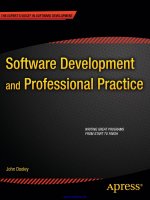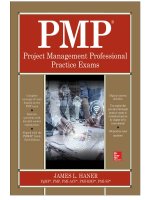Assignment 1 Professional Practice (1620 Distinction)
Bạn đang xem bản rút gọn của tài liệu. Xem và tải ngay bản đầy đủ của tài liệu tại đây (3.02 MB, 38 trang )
ASSIGNMENT 1 FRONT SHEET
Qualification
BTEC Level 5 HND Diploma in Computing
Unit number and title
Unit 3: Professional Practice
Submission date
Date Received 1st submission
Re-submission Date
Date Received 2nd submission
Student Name
Bui Quang Minh
Student ID
GCD210325
Class
GCD1104
Assessor name
Phan Thanh Tra
Student declaration
I certify that the assignment submission is entirely my own work and I fully understand the consequences of plagiarism. I understand that
making a false declaration is a form of malpractice.
Student’s signature
Grading grid
P1
P2
P3
P4
M1
M2
M3
D1
D2
Summative Feedback:
Grade:
Resubmission Feedback:
Assessor Signature:
Internal Verifier’s Comments:
Signature & Date:
Date:
Contents
A. INTRODUCTION ........................................................................................................................................................ 5
B. DEMONSTRATE, USING DIFFERENT COMMUNICATION STYLES AND FORMAT, THAT YOU CAN EFFECTIVELY
DESIGN AND DELIVER A TRANING EVENT FOR A GIVEN TARGET AUDIENCE (P1) ........................................................ 6
I. Definition and the importance of communication skill ......................................................................................... 6
1. Definition of communication skill ..................................................................................................................... 6
2. The importance of communication skill ........................................................................................................... 6
II. Verbal communication.......................................................................................................................................... 7
III. Non-verbal communication ................................................................................................................................. 7
IV. Communication in my group ............................................................................................................................... 8
C. DEMONSTRATE THAT YOU HAVE USED EFFECTIVE TIME MANAGEMENT SKILLS IN PLANNING AN EVENT (P2) ..... 9
I. Definition and the importance of time management skill .................................................................................... 9
1.1 Definition of time management skill .............................................................................................................. 9
1.2 The importance of time management skill ..................................................................................................... 9
II. Planning a training event (group work) .............................................................................................................. 10
2.1 Name of the Training program ..................................................................................................................... 10
2.2 Goals of the Training program ...................................................................................................................... 10
2.3 Participants ................................................................................................................................................... 10
2.4 Time .............................................................................................................................................................. 10
2.5 Place .............................................................................................................................................................. 11
2.6 Agenda .......................................................................................................................................................... 12
2.7 Work Breakdown Structure (WBS): .............................................................................................................. 14
2.8 GANTT chart .................................................................................................................................................. 15
2.9 Milestone ...................................................................................................................................................... 18
2.10 Estimated Budget........................................................................................................................................ 20
2.11 Notes ........................................................................................................................................................... 21
III. Design a professional schedule to support the planning of an event (M1)....................................................... 22
D. DEMONSTRATE THE USE OF DIFFERENT PROBLEM-SOLVING TECHNIQUES IN THE DESIGN AND DELIVERY OF AN
EVENT (P3) .................................................................................................................................................................. 23
I. Definition and the importance of problem solving ............................................................................................. 23
1.1 Definition of problem solving ....................................................................................................................... 23
1.2 The importance of problem solving .............................................................................................................. 23
II. Some techniques and tools for the problem solving .......................................................................................... 24
2.1 Techniques for problem solving.................................................................................................................... 24
2.2 Tools for problem solving ............................................................................................................................. 26
III. Problems and solutions in the training event .................................................................................................... 28
IV. The use of different problem-solving techniques used in the design and delivery of an event (M2) .................. 29
E. DEMONSTRATE THAT CRITICAL REASONING HAS BEEN APPLIED TO A GIVEN SOLUTION (P4).............................. 32
I. Definition and the importance of critical reasoning ............................................................................................ 32
1.1 Definition of critical reasoning ...................................................................................................................... 32
1.2 The importance of critical reasoning ............................................................................................................ 33
II. Apply to a given solution .................................................................................................................................... 33
2.1 Problem occurred when finding solution for setting the introductory time at the first of this event ......... 33
2.2 Problem occurred when finding solution for setting the “Thank You” party in the end of this training evnet
............................................................................................................................................................................ 34
III. Justify the use and application of a range of solution methodologies (M3) ..................................................... 34
F. EVALUATE THE EFFECTIVENESS AND APPLICATION OF INTERPERSONAL SKILLS DURING THE DESIGN AND
DELIVERY OF A TRAINING EVENT (D1) ........................................................................................................................ 35
1. Importance of interpersonal skills .................................................................................................................. 36
2. Used interpersonal skills during the design and delivery of the event .......................................................... 36
3. Effectiveness of different interpersonal skills................................................................................................. 37
G. CRITIQUE THE PROCESS OF APPLYING CRITICAL REASONING TO A GIVEN TASK/ ACTIVITY OR EVENT (D2)......... 37
REFERENCE LIST .......................................................................................................................................................... 38
A. INTRODUCTION
Nowadays, thanks to the development of technology, we are living in a world where technology
devices appear around us. When I go to the supermarkets I see people around me using smartphones
and laptops everywhere. So that I think that what should I do to make people at home but they still
buy items online? That is why I and my team come up with creating a website, an app that helps
people shop online without going out.
We do the market and conduct conveys about consumers’ demand. All of them want to buy goods
such as clothes, food, or even personal items at home. I know that going out to buy this stuff can
make them feel good but if people live in a city that contains a lot of people it is dangerous for them
when going out. I think that staying at home to buy those is the best way.
In this assignment, our team has created an event that will introduce all people to an application.
People will get a new view of buying items online. Please, follow me and our team to not miss any
points.
Figure 1. Shopping online illustration
B. DEMONSTRATE, USING DIFFERENT COMMUNICATION STYLES AND FORMAT,
THAT YOU CAN EFFECTIVELY DESIGN AND DELIVER A TRANING EVENT FOR A GIVEN
TARGET AUDIENCE (P1)
I. Definition and the importance of communication skill
1. Definition of communication skill
The abilities you use when offering and receiving various types of information are known as
communication skills. Examples include expressing new thoughts, emotions, or even an update on
your project. The four Cs of communication are listening, speaking, observing, and empathizing.
Understanding the contrasts between face-to-face contacts, phone calls, and digital communications
like email and social media is also beneficial.
5 ESSENTIAL COMMUNICATION SKILLS
WRITTEN COMMUNICATION
Write in order to communicate thoughts and facts.
ORAL COMMUNICATION
Use spoken language to communicate thoughts and facts.
NON-VERBAL AND VISUAL COMMUNICATION
Describe concepts and facts using images or other verbal or nonverbal signals.
ACTIVE LISTENING
Effective communication involves summarizing and restating what you hear in your own words to
ensure that everyone has understood. Active listening encourages communication, prevents
misunderstandings, resolves disagreements, and fosters trust.
CONTEXTUAL COMMUNICATION
efficiently communicate in a variety of circumstances, including those involving distinct populations,
people, situations, places, or behavioural types. This encompasses settings including the workplace,
cross-cultural communication, the internet, academic, and crisis communication.
2. The importance of communication skill
Strong communication abilities are beneficial in all area of life, including work, relationships, and
everything in between. From a commercial perspective, communication is the foundation of all
interactions. To understand information more properly and rapidly, both you and other people, you
must have effective communication skills. On the other hand, ineffective communication techniques
result in confusion and dissatisfaction rather frequently.
II. Verbal communication
Verbal communication is the exchange of information through speech with another person. Thus, it
can refer to both spoken and written communication. Yet, the term is frequently used to refer only to
oral communication. When it comes to the verbal component of communication, everything focuses
on the words you use and how they are heard and understood.
Figure 2. Verbal and non-verbal communication illustration
III. Non-verbal communication
The exchange of information through body language, gestures, facial emotions, created space, and
other nonverbal signals is known as nonverbal communication. For instance, smiling at someone when
you first meet them communicates warmth, acceptance, and openness.
Unlike verbal communication, which is the use of language to communicate information through
written text, speech, or sign language, nonverbal communication depends on facial expressions and
body movements.
IV. Communication in my group
My group name is BuDa including 4 members, we are Bui Quang Minh, Tran Quoc Trung, Vu Hoang
Nam, and Bui Thi Le Quynh.
March 25th, we gather and have an offline meeting to discuss about the event and start working.
Figure 3. Offline Meeting in class
After working together and asking some information of each member in group, we figure out the
characteristics; thus, we knew the positions that suitable for each member.
ROLE
NAME
Tran Quoc Trung
Event Organizer
Vu Hoang Nam
Event Manager
Bui Quang Minh
Technical Manager
Bui Thi Le Quynh
Health & Safety Officer
C. DEMONSTRATE THAT YOU HAVE USED EFFECTIVE TIME MANAGEMENT SKILLS IN
PLANNING AN EVENT (P2)
I. Definition and the importance of time management skill
Figure 4. Time Management illustration
1.1 Definition of time management skill
Time management is the coordination of tasks and activities to maximize the effectiveness of an
individual's efforts. In general, time management is used to help people do more, better work in less
time.
To make the most of the time available, time management techniques include organization,
planning, and scheduling. Techniques for time management also take into account a person's unique
circumstance as well as any related skills and traits.
1.2 The importance of time management skill
The value of time management is that it's able to give time purpose and enable individuals to
maximize their time. It is used in the corporate world to establish objectives and standards for
organizations and the people who work for them. Employees with good time management abilities
may produce high-quality work and accomplish their objectives. Time management also assists
managers in identifying employee potential and establishing practical objectives.
Employees with poor time management abilities miss deadlines, do subpar work, experience
excessive tension and anxiety, and run out of time. Ineffective time management negatively impacts
staff, management, and the business.
Time management advantages
Reduced absences. Employees that are stressed and exhausted use more sick days and other
vacations.
productivity improvements. Workers who like their jobs and are less inclined to miss work are
more productive.
happier workers. Employees are happier and less likely to experience burnout when they have
ample time to do their task.
increased creativity. Employees can be more creative in their job when they are not under
pressure from time restraints. Instead of simply responding to their job, they may actively
participate with it. This fosters creativity.
II. Planning a training event (group work)
2.1 Name of the Training program
Tiki - shopping paradise for customers
2.2 Goals of the Training program
GOAL
Provides information about how to sell using the Tiki platform.
Introduce advantages that Tiki provides its customers.
Instruct individuals on how to contact potential clients.
PURPOSE
Provide users with information on Tiki sales
Introduce advantages and savings when utilizing Tiki
Encourage users to make the most of available resources.
SCOPE
Organize events for about 200 - 500 audiences
Organize parties and light meals between and after the event.
Encourage the audience to make suggestions and ask questions during the event.
Organize a field trip at the company.
2.3 Participants
Up to 500 students, departments in company, and everyone who wants to join
2.4 Time
Saturday, March 25th – Friday, April 7th ,2023
2.5 Place
Mường Thanh Grand Đà Nẵng, 962 Ngô Quyền
Figure 5. Muong Thanh location
Figure 6. Meeting room
2.6 Agenda
The first day of the event “Tiki – shopping paradise for customers”
Time
Mission
Location
Speakers
8:00 AM8:14 AM
Check-in
Meeting room (6th
floor)
8:15 AM8:24 AM
Complete the check-in
Meeting room (6th
floor)
8:25 AM8:59 AM
Opening ceremony
Meeting room (6th
floor)
MC Tran Thanh
9:00 AM9:20 AM
Introduction about the
purpose of the event
Meeting room (6th
floor)
MC Tran Thanh
9:21 AM11:29 AM
Overview about the work
shop
Meeting room (6th
floor)
Tiki-pay
technology and
efficiency
11:30 AM11:59 AM
Discussion: Question and
Answer
Meeting room (6th
floor)
MC Viet and
Tiki Team
12:00 PM1:59 PM
Lunch and rest
Meeting room (6th
floor)
2:00 PM2:44 PM
The explosion of Tiki.
Meeting room (6th
floor)
Leader of Tiki
Team
2:45 PM4:00PM
Why sell so many
products in a certain time
Meeting room (6th
floor)
Technology
Specialist Da Nang
4:45 PM
Summary the speech
Meeting room (6th
floor)
MC Thien An
The second day of the event “Tiki – shopping paradise for customers”
Time
Mission
Location
Speakers
8:00 AM8:14 AM
Check-in
Meeting room (6th
floor)
8:15 AM8:24 AM
Complete the check-in
Meeting room (6th
floor)
8:25 AM8:59 AM
Opening ceremony
Meeting room (6th
floor)
MC Tran Thanh
9:00 AM9:20 AM
Start Meeting
Meeting room (6th
floor)
MC Tran Thanh
9:21 AM11:29 AM
Tiki marketing
academy
Meeting room (6th
floor)
Tiki-pay
technology and
efficiency
11:30 AM11:59 AM
Mini Game
Meeting room (6th
floor)
MC Viet and
Tiki Team
12:00 PM1:59 PM
Lunch and rest
Meeting room (6th
floor)
2:00 PM2:44 PM
The explosion of Tiki
p2.
Meeting room (6th
floor)
Leader of Tiki
Team
2:45 PM4:00PM
Why sell so many
products in a certain
time?
Meeting room (6th
floor)
Technology
Specialist Da Nang
4:45 PM
Summary the speech
Meeting room (6th
floor)
MC Thien An
The third day of the event “Tiki – shopping paradise for customers”
Time
Mission
Location
Speakers
8:00 AM8:14 AM
Check-in
Meeting room (6th
floor)
8:15 AM8:24 AM
Complete the check-in
Meeting room (6th
floor)
8:25 AM8:59 AM
Opening ceremony
Meeting room (6th
floor)
MC Tran Thanh
9:00 AM9:20 AM
Introduction about the
purpose of the event
Meeting room (6th
floor)
MC Tran Thanh
9:21 AM11:29 AM
Overview about the work
shop
Meeting room (6th
floor)
Tiki-pay
technology and
efficiency
11:30 AM11:59 AM
Discussion: Question and
Answer
Meeting room (6th
floor)
MC Viet and
Tiki Team
12:00 PM1:59 PM
Lunch and rest
Meeting room (6th
floor)
2:00 PM2:44 PM
Why should you use
Tiki?
Meeting room (6th
floor)
Leader of Tiki
Team
2:45 PM4:00PM
Minigame about
marketing
Meeting room (6th
floor)
Technology
Specialist Da Nang
5:00 PM
Summary the speech
Meeting room (6th
floor)
MC Thien An
The fourth day of the event “Tiki – shopping paradise for customers”
Time
Mission
Location
Speakers
8:00 AM8:14 AM
Check-in
Meeting room (6th
floor)
8:15 AM8:24 AM
Complete the check-in
Meeting room (6th
floor)
8:25 AM8:59 AM
Opening ceremony
Meeting room (6th
floor)
MC Tran Thanh
9:00 AM9:20 AM
Cultural performances
Meeting room (6th
floor)
MC Tran Thanh
9:21 AM11:29 AM
Break and relax
Meeting room (6th
floor)
Tiki-pay
technology and
efficiency
11:30 AM11:59 AM
Discussion: Question and
Answer
Meeting room (6th
floor)
MC Viet and
Tiki Team
12:00 PM1:59 PM
Lunch and rest
Meeting room (6th
floor)
2:00 PM2:44 PM
The explosion of Tiki.
Meeting room (6th
floor)
Leader of Tiki
Team
2:45 PM4:00PM
Why sell so many
products in a certain time
any time?
Meeting room (6th
floor)
Technology
Specialist Da Nang
4:45 PM
Summary the speech
Meeting room (6th
floor)
MC Thien An
2.7 Work Breakdown Structure (WBS):
A work breakdown structure (WBS) is a visual, hierarchical and deliverable-oriented deconstruction
of a project. It is a helpful diagram for project managers because it allows them to break down their
project scope and visualize all the tasks required to complete their projects.
Figure 7. Work breakdown structure
2.8 GANTT chart
A Gantt chart is a project management tool that illustrates work completed over a period of time in
relation to the time planned for the work. A Gantt chart can include the start and end dates of tasks,
milestones, dependencies between tasks, assignees, and more.
Figure 8. Example of Gantt Chart
Plan
Establish event
goal
Select events
day and place
Select
communications
protocol of team
Design working
schedule
Prepare slides
and document
Estimate the
budget
Coordinate with
event suppliers
Conduct a
thorough
evaluation of
the event
Send the
invitation to
guests
Quynh
Quynh
Trung
Trung
Quynh
Nam
Minh
25/03/202 25/03/202
80%
3
3
26/03/202 26/03/202
100%
3
3
26/03/202 26/03/202
100%
3
3
27/03/202
3
27/03/202
3
28/03/202
3
28/03/202
3
27/03/202
90%
3
27/03/202
75%
3
28/03/202
100%
3
28/03/202
50%
3
Minh
29/03/202 29/03/202
3
3
Nam
50%
29/03/202 29/03/202
100%
3
3
Implementation
Introduction
about the
purpose of the
event
Overview about
shopping online
The explosion of
shopping online
Quynh
03/04/202 03/04/202
100%
3
3
Quynh
Minh
03/04/202 03/04/202
100%
3
3
03/04/202 03/04/202
100%
3
3
07/03/2023
06/04/2023
05/04/2023
04/04/2023
03/04/2023
20/04/2023
01/04/2023
31/03/2023
30/03/2023
29/03/2023
28/03/2023
EVENT START: 25/03/2023
27/03/2023
%
Assigned to Start Date End Date Progress
26/03/2023
Task Name
25/03/2023
Tiki-Shopping just got easier
Why is shopping
online trending
nowadays?
Is it difficult
to use
Tiki
Introduction
about Tiki
The outstanding
features of
Shopee
Why should you
use Tiki?
Using Tiki
effectively.
The impact of
Shopee on
today's life
Job
opportunities
for students at
Tiki
Future plans of
Tiki
Minh
Trung
Trung
Nam
Nam
Minh
Trung
03/04/202 03/04/202
100%
3
3
04/04/202 04/04/202
100%
3
3
04/04/202 04/04/202
100%
3
3
05/04/202 05/04/202
100%
3
3
05/04/202 05/04/202
100%
3
3
06/04/202 06/04/202
100%
3
3
07/04/202 07/04/202
100%
3
3
Nam
07/04/202 07/04/202
100%
3
3
Nam
07/04/202 07/04/202
100%
3
3
2.9 Milestone
A milestone is a specific point within a project’s life cycle used to measure the progress toward the
ultimate goal. Milestones in project management are used as signal posts for a project's start or end
date, external reviews or input, budget checks, submission of a major deliverable, etc. A milestone is
a reference point that marks a significant event or a branching decision point within a project.
Branch name
Event training,
implementation
Planning
Establish event
goal
Select events day
and place
Select
communications
protocol of team
Design working
schedule
Prepare slides and
document
Estimate the
budget
Coordinate with
event suppliers
Conduct
a
thorough
evaluation of the
event
Send the
invitation to
guests
Implementation
Duration
112 hours
Start
26/03/2023
End
07/04/2023
56 hours
12 hours
25/03/2023
25/03/2023
31/03/2023
25/03/2023
4 hours
26/03/2023
26/03/2023
6 hours
26/03/2023
26/03/2023
6 hours
27/03/2023
27/03/2023
8 hours
27/03/2023
27/03/2023
4 hours
28/03/2023
28/03/2023
4 hours
28/03/2023
28/03/2023
6 hours
29/03/2023
29/03/2023
6 hours
30/03/2023
30/03/2023
56 hours
03/04/2023
28/03/2023
Performing the
workshops
Introduction
about the purpose
of the event
Overview about
shopping onl
The explosion of
shopping onl
Why is shopping
onl trending
nowadays?
Is it difficult to use
Tiki
Introduction
about Tiki
The outstanding
features of Tiki
Why should you
use Tiki?
Using Tiki
effectively.
The impact of Tiki
on today's life
Job opportunities
for students at
Tiki
Future plans of
Tiki
Organizing
minigames and
tea breaks
Opening
ceremony
27 hours
03/04/2023
07/04/2023
1 hours
03/04/2023
03/04/2023
1 hours
03/04/2023
03/04/2023
2 hours
03/04/2023
03/04/2023
2 hours
03/04/2023
03/04/2023
2 hours
04/04/2023
04/04/2023
3 hours
04/04/2023
04/04/2023
2 hours
05/04/2023
05/04/2023
2 hours
05/04/2023
05/04/2023
4 hours
06/04/2023
06/04/2023
2 hours
07/04/2023
07/04/2023
3 hours
07/04/2023
07/04/2023
3 hours
07/04/2023
07/04/2023
21 hours
08/04/2023
08/04/2023
4 hours
08/04/2023
08/04/2023
Mini game with
attractive gifts
Break (Drinks and
dessert)
Leisure activities
Mini game: Luck
number
Guide using
shopping onl
5 hours
09/04/2023
11/04/2022
4 hours
08/04/2023
11/04/2022
4 hours
4 hours
11/04/2022
11/04/2022
11/04/2022
11/04/2023
8 hours
10/04/2023
10/04/2023
2.10 Estimated Budget
Budget Types of cost Expected result True result Rented hall $900 $850 Decoration $400$ $350
Lunches for guests $3500$ $3100 Drink and dessert $400$ $320 Gift $80 $80 Inviting speaker
$500 $900 Team building $450 $400 Other fees $300 $120 Total $6530 $6120
Types of cost
Expected result
True result
Rented hall
$800
$800
Decoration
$300
$350
Lunches for guests
$1200
$990
Drink and dessert
$100
$80
Gift
$120
$120
Inviting speaker
$800
$700
Team building
$350
$340
Other fees
$100
$200
Total
$3770
$3580









